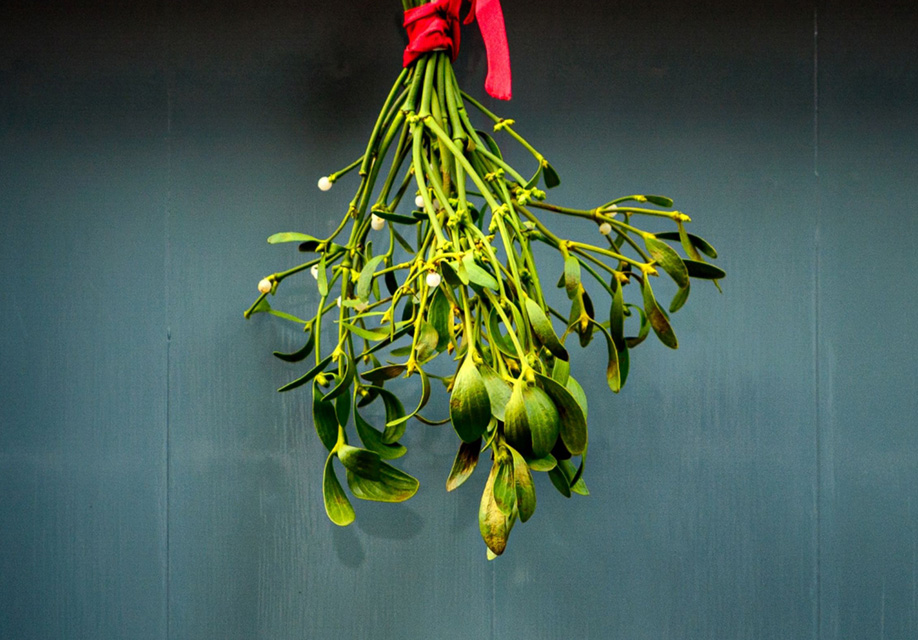
courtesy photo
Mistletoe’s white berries ripen in December, and while toxic to humans, are a welcome feast for many species of birds and animals.
by Deborah J. Benoit, Extension Master Gardener, University of Vermont
NORTH ADAMS, Mass. – The mention of mistletoe evokes images of a seasonal kissing ball adorned with its leaves and berries or of someone sneaking a kiss beneath a sprig of mistletoe hanging in a doorway. You probably don’t think about where mistletoe comes from or what part it plays in the ecosystems where it grows in the wild.
While there are over 1,300 species of mistletoe throughout the world, the one we’re most familiar with and what we see in stores during the holiday season each year is typically American mistletoe (Phoradendron serotinum). You may hear it called by other names, such as eastern mistletoe, hairy mistletoe or oak mistletoe.
This flowering perennial plant is native to the southeastern regions of the United States. American mistletoe is hardy only to U. S. Department of Agriculture Plant Hardiness Zone 6, so you won’t find it growing in the wild in Vermont.

courtesy photo
Mistletoe’s white berries ripen in December, and while toxic to humans, are a welcome feast for many species of birds and animals.
The Greek word phoradendron translates to “thief of the tree” in English. Mistletoe is a semi-parasitic plant (called a hemiparasite) and, therefore, is considered a plant disease. It must have a living host plant to survive.
Its roots attach and tap into a host tree, extracting water and nutrients. It then uses those resources along with sunlight and the chlorophyll (the green pigment) in its foliage to manufacture food through photosynthesis.
Mistletoe grows into large, thick clumps on the branches of deciduous trees. Its evergreen foliage makes it easy to see during the late fall and winter months when the host tree’s foliage has fallen.
While mistletoe does take nutrients from its host, a healthy tree is unlikely to be significantly harmed by its presence. However, it may cause damage to the portion of the branch beyond its location. In addition, a severe infection of numerous mistletoe plants on a single host can stress the tree, making it more susceptible to disease or other problems. Fortunately, mistletoe spreads slowly so it is not a threat to forested areas.
Mistletoe spreads with the help of birds who consume its berries. The seeds, which have traveled through a bird’s digestive system, are then deposited onto host trees. Seeds also spread when they adhere to birds’ feathers or animals’ fur.
Once germination takes place, mistletoe’s roots penetrate the bark of the host tree and appropriate nutrients and moisture from the tree. While its evergreen foliage allows mistletoe to perform photosynthesis, providing it with some of its needed nutrients, mistletoe does require a living host to survive and to reproduce.
Mistletoe produces small, white flowers in late spring and early summer. The flowers are followed by white berries.
All parts of the mistletoe plant are toxic to humans, and coming into contact with the plant may produce an allergic reaction and cause skin irritation or a rash for some people. Be sure to keep mistletoe, and its berries in particular, away from pets and small children.
On the other hand, the nectar of mistletoe flowers provides a nutritious feast for pollinators. Mistletoe berries, which ripen in December, are a welcome food source for birds and animals during the winter months. The thick bunches of intertwined branches provide habitat and cover for birds and small, tree-dwelling mammals throughout the year.
So, the next time you see a sprig of mistletoe this holiday season, remember the part it plays in nature all year long.
For more information on mistletoe and its place in the ecosystem, see go.uvm.edu/mistletoe.
[Deborah J. Benoit is a UVM Extension Master Gardener from North Adams, Mass., who is part of the Bennington County Chapter.





